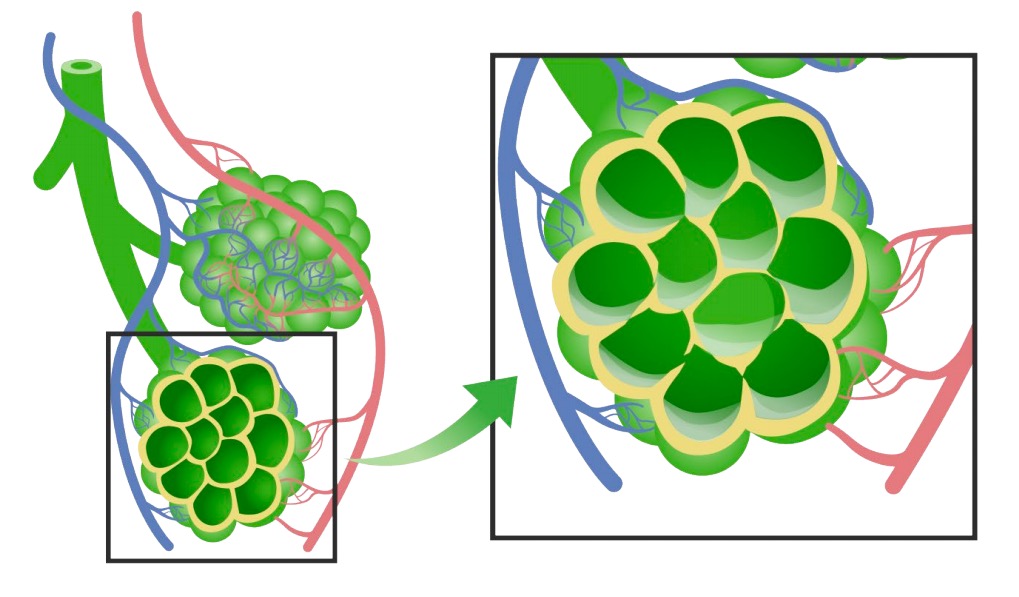Playlist
Show Playlist
Hide Playlist
HAPE – Effect of Barometric Pressure on the Pulmonary System
-
Slides 06 PulmonaryBarometricPressure RespiratorySystem.pdf
-
Download Lecture Overview
00:02 High altitude pulmonary edema is the last disorder that we’re going to go through. 00:06 Its big processes are dyspnea, which is shortness of breath, and you can cough up bloody sputum and sometimes that’s even frothy. And what it makes it frothy is sometimes you’re also coughing up the particular surfactants that are in your lungs. There’s also a warmth that is oftentimes felt in various portions in lung and part of that process is probably not only the dyspnea but the edema portion that you’re actually sensing. 00:37 How does this occur in terms of its pathophysiology? Well, it’s not exactly understood. 00:43 But there’s a couple of very good theories out there. 00:46 This picture is just showing some of the alveoli starting to fill up with fluid. And I emphasize this point because if alveoli are filled with fluid, they cannot undergo gas exchange. You can’t undergo gas exchange and you’re not getting O2 and not getting rid of CO2. 01:04 High altitude pulmonary edema, its pathophysiology is not fully understood. However, pulmonary hypertension seems to be part of the root cause. 01:14 And this maybe because of the increase in pulmonary artery pressure that occurs during hypoxia. 01:21 This pulmonary vasoconstriction is probably due to that low oxygen and it might not be uniform to cross the entire lung. 01:29 But what happens that increase in pulmonary artery pressure might cause stress failure of certain pulmonary capillaries. 01:38 So let me show you what that might look like. 01:41 So in high altitude pulmonary edema, they believe that there is this stress failure in the pulmonary capillary. 01:46 And that can be viewed in this figure on the left. Where between the two green arrows, is where the stress failure occurred. 01:53 And that is damage of a pulmonary capillary. 01:56 But what is important to think about this from an edema point of view is what was in the blood is going to be spilled out into the interstitial fluid. 02:06 That’s going to pull other fluid with it and you can, on the right side, see the pulmonary edema in terms of an x-ray. 02:17 So how do you try to prevent and treat high altitude pulmonary edema? Of course, just like the other mountain sicknesses, gradual ascension is very important. There is some pharmacology that can sometimes help such as vasodilators, For Treatment, the most important thing is to get the person off the mountain. 02:31 They need to descend to a lower barometric pressure, which can can bce simulated by gradually lowering the pressure in a pressurized chamber). 02:40 Pharmacologic treatment includes giving oxygen and nifedipine, a calcium channel blocker.
About the Lecture
The lecture HAPE – Effect of Barometric Pressure on the Pulmonary System by Thad Wilson, PhD is from the course Respiratory Physiology.
Included Quiz Questions
Which of the following is NOT part of the pathophysiology of high-altitude pulmonary edema?
- Vasodilation of pulmonary arteries leading to spillage of blood
- Increase in pulmonary artery pressure
- Filling of alveoli with fluid
- Stress failure of pulmonary capillaries
- Vasoconstriction of pulmonary arteries
Which of the following is the generally accepted sequence of events leading to high altitude pulmonary edema (HAPE)?
- Hypoxia => pulmonary vasoconstriction => pulmonary hypertension => stress failure of pulmonary capillaries => accumulation of extravascular fluid in the alveolar spaces that impairs gas exchange
- Hypoxia => pulmonary vasoconstriction => stress failure of pulmonary capillaries => pulmonary hypertension => accumulation of extravascular fluid in the alveolar spaces that impairs gas exchange
- Hypoxia => pulmonary hypertension => pulmonary vasoconstriction => stress failure of pulmonary capillaries => accumulation of extravascular fluid in the alveolar spaces that impairs gas exchange
- Hypoxia => stress failure of pulmonary capillaries => pulmonary vasoconstriction => pulmonary hypertension => accumulation of extravascular fluid in the alveolar spaces that impairs gas exchange
- The correct sequence is not listed.
Customer reviews
5,0 of 5 stars
| 5 Stars |
|
5 |
| 4 Stars |
|
0 |
| 3 Stars |
|
0 |
| 2 Stars |
|
0 |
| 1 Star |
|
0 |




